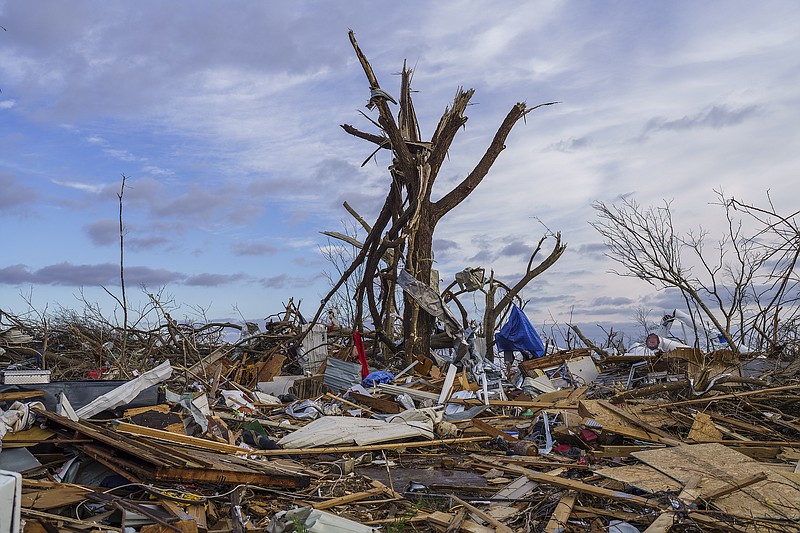Was it just another tornado? Or is it climate change? We hear questions like this - and wonder about questions like this - every time there is a terrible outbreak of twisters, a horrible flood, a raging, racing wildfire.
We're right to wonder, as climatologists are increasingly agreeing.
"Hotter, faster, stronger: That isn't a tagline for the next blockbuster superhero movie. This is what climate change is doing to many extreme weather events," wrote atmospheric scientist Katharine Hayhoe and Environmental Change Institute associate director Friederike Otto last August in an opinion essay in The New York Times.
"As the planet warms, heat waves are getting hotter, wildfires are moving faster and burning larger areas, and storms and floods are becoming stronger," their essay continued. "These effects are no longer a future or distant concern: They are affecting us - all of us - here and now. We are already living in a world that is two degrees Fahrenheit warmer than it was at the outset of the Industrial Revolution. That means that every weather event is already superimposed over the background of a changed climate."
Now, less than a week after Friday night's so-called quad-state tornado carved a 128-mile continuous path as part of an outbreak that covered 250 miles across Arkansas, Missouri, Tennessee and Kentucky, another scientist, tornado climatologist and Florida State University professor James Elsner, has sounded a similar alarm in the opinion pages of the Times.
Increasingly, Elsner wrote, tornadoes are not single occurrences but rather happen in "outbreaks." And outbreaks are becoming more common in cooler months and more common across the Southeast, compared with the Great Plains. What's more, they are getting stronger.
"Cities with the largest decreases in the number of strong tornadoes since 1984 include Dallas, Oklahoma City and Houston. Cities with the largest increases in the number of strong tornadoes since 1984 are Atlanta, Nashville and Augusta."
Precisely what's causing all these changes in tornado behavior is still unclear, Elsner wrote, "but global warming is probably playing a role through changes to the environments that support supercell clusters. Specifically, the extra heated moist air fueling the supercells on Friday was associated with an exceptionally warm Gulf of Mexico caused by climate change."
Scientific American weighed in on Tuesday with this observation from John Allen, a meteorologist and climate scientist at Central Michigan University: "From touchdown to dissipation, the Quad-State Tornado may have spent a stunning four hours on the ground. Most tornadoes survive for no more than 10 to 20 minutes."
Allen and other scientists said the twister was able to last so long with the right atmospheric conditions - heat and muggy air with temperatures more characteristic of April than December - and lots of wind shear (winds blowing from different directions at different heights in the atmosphere) owing in part to La Nina conditions that often lead to cool-season storms in the Southeast.
Sound familiar? It should.
The super outbreak that became known as the Dixie Outbreak from April 25-28 in 2011 had much that kind of description, according to what weather experts told The Associated Press several months later: "It was part of an active weather pattern ... with strong storms moving through the center of the country, tapping into moisture from the Gulf of Mexico as they matured across the mid-Mississippi Valley. Contributing to the thrashing were the La Nina conditions in the Pacific Ocean, unusually warm ocean temperatures in the Gulf of Mexico and the increase of moisture in the atmosphere caused by the warming climate."
That 2011 outbreak spawned at least 362 tornadoes across the Southeast, killing more than 340 people, including at least 79 here in Chattanooga's tri-state region.
Here's just one more "wow" storm statistic for you today - this one from the Nashville Tennessean.
More than a third of all December tornadoes confirmed in Tennessee over the past seven decades happened in 2021. From 1950 to 2020, Tennessee saw 30 twisters during the 12th month of the year, according to data from National Oceanic and Atmospheric Administration. But this year, in just the first two weeks of December, the state has confirmed 18 tornadoes.
The most deadly of those storms happened last week in western Kentucky, where at least 74 died, and more than 100 people were still unaccounted for Tuesday. Another 14 people were killed in five other states, including four in Tennessee.
There's a silver lining to all this scary tornado and weather research: better forecasting. A Mayfield, Ky., gas station cashier told New York Times reporters that she checked the weather all day as alerts beeped over her cellphone.
"There's no way a single person here didn't know the storm was coming. ... They said it would hit at 9:30 [p.m.] and it hit at 9:30," Morgan Jackson said.
Would that we all begin to pay more attention to those alerts, and to the long-term warnings of scientists, as well.
